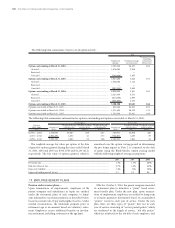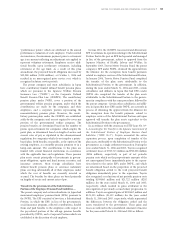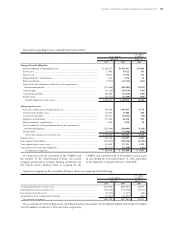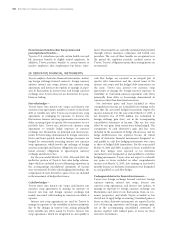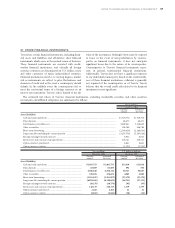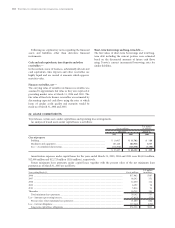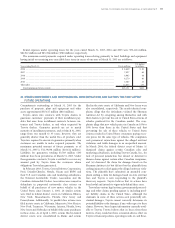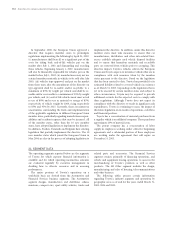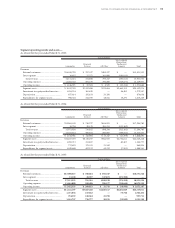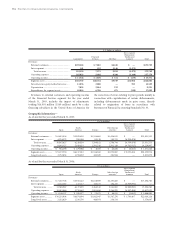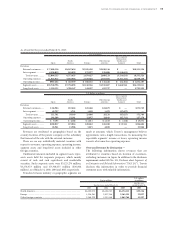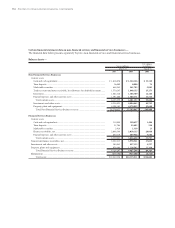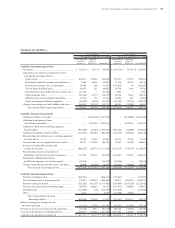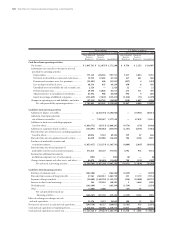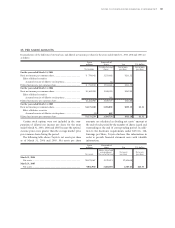Toyota 2005 Annual Report Download - page 114
Download and view the complete annual report
Please find page 114 of the 2005 Toyota annual report below. You can navigate through the pages in the report by either clicking on the pages listed below, or by using the keyword search tool below to find specific information within the annual report.
112 >NOTES TO CONSOLIDATED FINANCIAL STATEMENTS
In September 2000, the European Union approved a
directive that requires member states to promulgate
regulations implementing the following by April 21, 2002:
(i) manufacturers shall bear all or a significant part of the
costs for taking back end-of-life vehicles put on the
market after July 1, 2002 and dismantling and recycling
those vehicles. Beginning January 1, 2007, manufacturers
will also be financially responsible for vehicles put on the
market before July 1, 2002; (ii) manufacturers may not use
certain hazardous materials in vehicles to be sold after July
2003; (iii) vehicles type-approved and put on the market
from three years after the amendment of the directive on
type-approval shall be re-usable and/or recyclable to a
minimum of 85% by weight per vehicle and shall be re-
usable and/or recoverable to a minimum of 95% by weight
per vehicle; and (iv) end-of-life vehicles must meet actual
re-use of 80% and re-use as material or energy of 85%,
respectively, of vehicle weight by 2006, rising respectively
to 85% and 95% by 2015. Currently, there are numerous
uncertainties surrounding the form and implementation
of the applicable regulations in different European Union
member states, particularly regarding manufacturer respon-
sibilities and resultant expenses that may be incurred. All
of the member states, other than the 10 new member
states, have adopted legislation to implement the directive.
In addition, Sweden, Denmark and Belgium have existing
legislation that partially implements the directive. The 10
new member states which joined the European Union in
May 2004 are also in the process of adopting legislation to
implement the directive. In addition, under this directive
member states must take measures to ensure that car
manufacturers, distributors and other auto-related busi-
nesses establish adequate used vehicle disposal facilities
and to ensure that hazardous materials and recyclable
parts are removed from vehicles prior to scrapping. This
directive impacts Toyota’s vehicles sold in the European
Union and Toyota expects to introduce vehicles that are in
compliance with such measures taken by the member
states pursuant to the directive. Based on the legislation
that has been enacted to date, Toyota has provided for its
estimated liability related to covered vehicles in existence
as of March 31, 2005. Depending on the legislation that is
yet to be enacted by certain member states and subject to
other circumstances, Toyota may be required to provide
additional accruals for the expected costs to comply with
these regulations. Although Toyota does not expect its
compliance with the directive to result in significant cash
expenditures, Toyota is continuing to assess the impact of
this future legislation on its results of operations, cash flows
and financial position.
Toyota has a concentration of material purchases from
a supplier which is an affiliated company. These purchases
approximate 10% of material costs.
The parent company has a concentration of labor
supply in employees working under collective bargaining
agreements and a substantial portion of these employees
are working under the agreement that will expire on
December 31, 2005.
The operating segments reported below are the segments
of Toyota for which separate financial information is
available and for which operating income/loss amounts
are evaluated regularly by executive management in
deciding how to allocate resources and in assessing
performance.
The major portions of Toyota’s operations on a
worldwide basis are derived from the Automotive and
Financial Services business segments. The Automotive
segment designs, manufactures and distributes sedans,
minivans, compact cars, sport-utility vehicles, trucks and
related parts and accessories. The Financial Services
segment consists primarily of financing operations, and
vehicle and equipment leasing operations to assist in the
merchandising of Toyota’s products as well as other
products. The All Other segment includes the design,
manufacturing and sales of housing, telecommunications
and other business.
The following tables present certain information
regarding Toyota’s industry segments and operations by
geographic areas as of and for the years ended March 31,
2003, 2004 and 2005:
24. SEGMENT DATA


